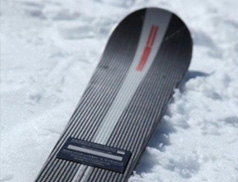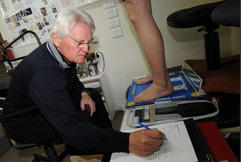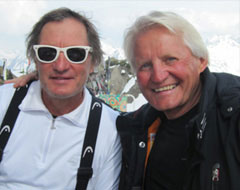
History Of Skiing
Skiing has existed since time immemorial. The old historic legends bear witness to this. In a cave in the north of Russia can be found what may be the oldest wall painting in the world representing a skier. Its age? Beyond doubt, several thousands of years! In Sweden, geologists have dated fragments of antique skis as being four thousand years old.
Below is a condensed history that marks some of the major milestones that have seen the world of Snow Sports evolve. Thanks to all the FIS historians for their contributions to this page.
6300-5000 BC
Oldest skis found in Russia near Lake Sindor (about 1,200km northwest of Moscow). Skis made of hard wood. (1)
6000 BC
The word ‘ski’ (from suksi) was used in Finland. (2)
5100 BC
Oldest ski found in Norway was Vefsn Nordland Ski. (3)
4000 BC
Rock carvings depicting skiing found at Bøla, Norway. (4)
3000 BC
Bog finds and rock paintings in Russia and Scandinavia prove the use of skis by people at that time. Half a ski and pole were found in Latvia and a ski found in Pskov, Russia. Kalvatrask ski. Finds include a nearly complete ski, one other parts and a pole with a long shovel. Information from the late Jakob Vaage, 1984.
2700 BC
Two complete skis and a pole dating from this time were dug out of a bog at Kalvträsk Sweden, in 1924. Carbon dating proved them to be c. 3300 BC. (5)
1700 BC
1700-1500 BC Bronze age rock carvings including a skier on Aeskove Cultur. Also clay vessel with illustration of skier
200 BC – 200 AD
China. First known documentary reference to skiing from the West Han period. (6)
618-907
The Chinese referred to Mongol-Turkish tribes in the official history of the Tang dynasty: The wooden-horse Turks are accustomed to skim over the ice on so-called wooden horses, that is, on sledges (or runners) which they bind to their feet to run over the ice. (7)
629
Thieh-lo tribe brought tribute riding on pieces of wood hunt deer over the ice. (8)
1199
Battle between Finnmarkers and Danes who used skis. (9)
1206
The Birkebeiners, Thorstein Skevla and Skjervald Skrukka rescued the 2-year-old Prince Hakon Hakonson, heir to the throne, skiing over the Dovre mountains from Lillehammer to Osterdalen. Since 1932 the Birkebeiner race has been run along the supposed route from Rena to Lillehammer. (10)
1518
Von Herbertstein travelled from Vienna to Moscow and described skiers in his book: Rerum Moskoviticumpublished in 1556. The skiers carried one stick and had short skis. (11)
1520
Rules were made about hunting on skis in Norway. (12)
1521 – 1522
Fenno-Sweden’s Kustaa Eeriksson later the king (Gustav Vasa) led the fight of the Taala people against the Danish troops and they used skis. He also asked many of his warlords to equip troops with skis. . (13)
1733
First rules for military on skis made by Jens Henrik Emahusen (1688-1752). (14)
1741
First depiction of skier with two poles. (15)
1800
In the Telemark area, where skis were necessary to get about, the people used them with great skill for health and pleasure. Skiing spread quite quickly all over Norway. (16)
1825
Sondre Norheim. Born 10 June Morgedal, NOR, died 9 March 1897 North Dakota, USA. Improved ski and binding design. Introduced Telemark.
1855-1861
Skiing reported in New Zealand and Australia. (17)
1856
Mathias Zdarsky born Koschichowitz CZE 25 February, died St Polten, 20 June 1940. Founder of Alpine skiing technique, including the stem turn, which he taught on the steep slopes of Lilienfeld. Invented competitions through gates. He shortened skis, invented firmer bindings and used single pole.
1860
Waxes: called ‘Moko’’from Chinese who called anything that would “make go” the skis ‘Moko’. (18)
1863 – 21 January
Run with a jump competition included the first known name of a female; 16 year old Ingrid Olsdatter Vestbyen. (19)
1879
Ivar Holmquist born SWE, died 1954 First President of International Ski Federation, (FIS) 1924-34. Lt-General of Swedish Army; President of Association for Promotion of Skiing & Open Air Activities, in Sweden 1923-1950.
1881
John F. Baddely founded Yukki Ski Club at St Petersburg – the earliest English ski club. (20)
1883
Cross -Country and ski jumping events were developed at Huseby. Whoever got the most points in the two disciplines was the winner. A cup was awarded for a women’s race. (21)
1886
9 March. Helsinki Sports Club organised ski competition. 16.5 km Cross Country and ski jumping. Finns jumped using sticks. A Norwegian engineer, Nielsen, won – without sticks. (22)
1893
First attempts to make lightweight laminated cross country skis to replace heavy hickory skis, by H.M. Christiansen, Edvard Lillehagen and Thorvald Hansen of Oslo. Contemporary glues insufficiently water-resistant. (23)
1900
First German ski championships on the Feldberg, 3 February 1900, won by Bjarne Nilssen. (24)
1901
Nordiska Spelen, -First Nordic Ski Games in Stockholm, 9-12 February.Baron Pierre de Coubertin, founder of the modern Olympic Games called them the Scandinavian Olympiade and suggested they should be organised every two years alternating between Stockholm and Christiania (Oslo). Falkner: Meilensteine Ljenggren and Lindroth in Goksoyr (25)
1905
Finland’s first wooden ski-jump built in Alppila, Helsinki. Pekka Honkanon (26)
1907
10 March First Italian ski competition organised by Milan Ski Club in the Valsassina. (27)First accident insurance for skiers and mountaineers offered by Naturfreund of Austria in Vienna.
1908
First skilift in the world set up in Schollach, Schwarzwald. It rose 75 m and was 550 m long. (28)
1910
18 February. First International Ski Commission, Oslo NOR. Dahl NOR became president. 22 delegates from 10 countries. Forerunner of FIS (29)
1915
Skiing first mentioned as a tourist attraction, when the Hermitage at Mt Cook (NZL), opened (30)
1918
26th October Marc Hodler born. President of the International Ski Federation 1951-1998.
1923
Ladies Ski Club Founded by Arnold Lunn at Mürren to encourage alpine racing for ladies. (31)
1928
Segmented steel edge for alpine skis invented by Rudolph Lettner, a skier and metal worker from Salzburg, Austria. Lettner patented steel edges, intending to prevent skis from wearing down. His daughter, a racer, also found the edges provided vastly improved grip on hard snow. (32)
1931
First FIS Alpine World Championships, Murren, SUI organised by the British. (33)
1936
First Winter Olympic Games to include Alpine races (Slalom and Downhill but medal awarded for Combined only) for men and women. Nordic Relay Race introduced. (GER).
1939
Zakopane, POL. FIS Nordic & Alpine World Championships including Cross Country, Jumping, Nordic Combination, Slalom, Downhill and Combined.
1951
Steve Bradley introduced first “mogul cutter” slope grooming machine at Winter Park, Colorado.
1952
Winter Olympic Games, Oslo, NOR. West Germans entered but no East Germans. Giant Slalom became an Olympic discipline. Women’s races included.
1955
Skimatting used for the first time in the world at Oberhof. Hans Renner (Jumping coach) says it revolutionizes training for ski jumping and Nordic Combined. (35)
1957
Bob Lange made the first plastic ski boot. Commercial introduction came in 1964 after adoption of buckles. Also first step-in binding made by Cubco. (no source)
1959
First death in official Alpine championships causes FIS to rule that helmets must be worn. (36)
1965
The start of snowboarding. Sherman Poppen patented first Snurfer and went into production. At first it had no edges or bindings. (37)
1971
The first Exhibition (Freestyle) national championships were held at Snowbird.
1972
First FIS World Championships in Ski Flying. Planica JUG.
1982
Nordic World Championships Oslo NOR. New skating step adopted with shorter skis made of carbon fibre. Nordic combination team event and 90m jump team event included. (38)
1984
The Gundersen method of Nordic combination was introduced. Competitors start the Cross Country according to points awarded for jumping and the winner is the racer who reaches the finish first.
1986
Developed in Australia, the Ultrasight Skigoggle lens was introduced by Carrera International
1987
At the Nordic Ski World Championships Cross Country races were held using both classical and skating steps. At the Alpine World Championships the Super-G was introduced.
1996
First FIS Snowboard World Championships. Lienz, AUT. Giant Slalom, Parallel Giant Slalom; Parallel Slalom, Halfpipe and Snowboard Cross. The Grass Skiing World Cup is introduced.
2002
At the German/Austrian Four-Hills-Tournament, Sven Hannawald (GER) became the first ever to win all four competitions and the overall ranking.
2005
First introduction of the scientifically based Skimetric concept www.skimetric.com a physical, biomechanical and equipment based analytical performance program for snowsports athletes.
2006
Simone Origone (ITA) set a new speed record at Les Arcs (FRA) of 251.40 kph. Raising the ladies’ speed record. Sanna Tidstrand (SWE) reached 242.59 kph.
2014
Women’s Ski Jumping to make debut at the Olympic Winter Games in Sochi (RUS).





